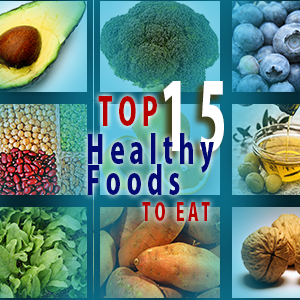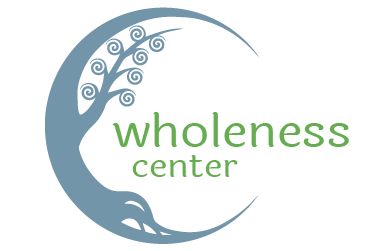Top Healthiest Foods
 These 15 top healthiest foods help you feel good, increase your energy and help prevent diseases. They are excellent sources of vitamins, minerals, fiber and other nutrients. Be sure your shopping cart has these healthy foods when you check out at your next visit to the grocery store!
These 15 top healthiest foods help you feel good, increase your energy and help prevent diseases. They are excellent sources of vitamins, minerals, fiber and other nutrients. Be sure your shopping cart has these healthy foods when you check out at your next visit to the grocery store!
Blueberries
Blueberries are loaded with Vitamin C, fiber, phytonutrients and antioxidants that help prevent chronic diseases, such as heart disease, diabetes and some cancers. Blueberries may also improve short-term memory and promote healthy aging.
Tip: Toss fresh blueberries on your yogurt or oatmeal in the morning. Buy extra in the summer and keep in the freezer for the winter months.
Lemons
Just one lemon has more than 100 percent of your daily intake of vitamin C, which may help increase “good” HDL cholesterol levels and strengthen bones. Citrus flavonoids found in lemons may help inhibit the growth of cancer cells and act as an anti-inflammatory. Also lemons are a great support for your liver to help in detoxifying your body.
Tip: Add a slice of lemon to your green tea. The citrus will help your body absorb the anti-oxidants in the tea.
Apples
Apples are a good source of soluble fiber, which can lower blood cholesterol and glucose levels. Fresh apples are also another good source of vitamin C — an antioxidant that protects your body’s cells from damage. Vitamin C also helps form the connective tissue collagen, keeps your capillaries and other blood vessels healthy, and aids in the absorption of iron.
Tip: Sliced apples are a great snack topped with a nut butter during the day or before bed.
Broccoli
Even though President Bush did not like broccoli, it’s one of the best vegetables to include in your diet! One medium stalk of broccoli contains more than 100% of your daily vitamin K requirement for bone health and almost 200% of your recommended daily dose of vitamins for cell health. Broccoli is an excellent source of Vitamin A for your eyes, folate for gene health and sulforaphane to prevent cancer.
Tip: Steam broccoli for just 3-4 minutes until it’s crispy to free up more of the available nutrients.
Sweet Potatoes
The deep orange-yellow color of sweet potatoes tells you that they’re high in the antioxidant beta-carotene, which is converted to vitamin A in your body. This nutrient may help slow the aging process and reduce the risk of some cancers. Sweet potatoes are a good source of fiber, vitamin C, vitamin B-6 and potassium.
Tip: Like all vegetables, they’re fat-free and relatively low in calories — one-half of a large sweet potato has just 81 calories.
Salmon
Salmon is a great source of omega-3 fatty acids, which have been linked to a reduced risk of depression, heart disease, and cancer. In addition to containing the good source of saturated fat, it doubles as a good source of protein too! A 3-ounce serving contains almost 50 percent of your daily dose of niacin, which may protect against Alzheimer’s disease and memory loss.
Tip: Choose wild-raised salmon from clean sources to avoid toxic polychlorinated biphenyls (PCBs).
Walnuts
Walnuts are chuck full of the omega-3 fatty acids, which may help reduce cholesterol, reduce the risk of heart disease and fight cancers. Omega-3s have also been shown to improve mood and may protect against sun damage, too (but don’t skip the SPF sunscreen!)
Tip: Eat a few for dessert – the antioxidant melatonin, found in walnuts, helps to regulate sleep!
Almonds
These tear-shaped nuts are packed with nutrients — fiber, riboflavin, magnesium, iron and calcium. In fact, one serving (about seven almonds) has more calcium than any other type of nut — 22 milligrams. One serving also provides almost 15 percent of the Recommended Dietary Allowance (RDA) of vitamin E. And they’re good for your heart.
Tip: Sprinkle sliced almonds on your smoothies, salads, and veggies – a quick way to get some added protein and a boost of energy!
Avocados
Avocados are a great source for monounsaturated healthy fats, which help to lower cholesterol and reduce your risk of heart disease. These nutritious fruits are good sources of fiber, potassium, thiamine, riboflavin, niacin, folate and vitamins B-6, E and K.
Tip: Avocados are high in calories, so if you are watching calories, keep your intake to no more than ½ avocado a day.
Garlic
Garlic has anti-bacterial, anti-fungal and anti-viral properties! It’s disease fighting potential comes from it’s sulfur constituents which act as antioxidants and clear the free-radicals running around your body. Allicin, another compound in garlic, works as an anti-inflammatory and may help lower cholesterol and blood pressure levels.
Tip: Crushed fresh garlic releases the most allicin. Just don’t overcook; garlic exposed to high heat for more than 10 minutes loses important nutrients. Try to eat 1 clove of garlic everyday!
Olive Oil
Olive oil is one of the healthiest fats in the world and can help lower “bad” LDL cholesterol and raise “good” HDL cholesterol – thanks to it’s monounsaturated fats! Olive oil is also packed with antioxidants called phenols, which may protect artery walls from building up cholesterol.
Tip: Buy “virgin, extra-virgin or cold-pressed” oils, which are extracted by pressing alone. Solvents and heat used to produce “light or extra-light” olive oils will destroy the anti-oxidant properties. Note that your use of olive oil will replace butter and stick margarine – not in addition to them!
Spinach
Spinach is high in vitamins A and C and folate. It’s also a good source of magnesium. The plant compounds in spinach may boost your immune system. The carotenoids found in spinach — beta-carotene, lutein and zeaxanthin — also are protective against age-related vision diseases, such as macular degeneration and night blindness, as well as heart disease and certain cancers.
Tip: Spinach is a healthy — and flavorless — addition to any smoothie. You won’t even taste it! Try blending 1 cup spinach, 1 cup grated carrots, 1 banana, 1 cup apple juice, and ice.
Legumes
Eating a serving of legumes (beans, peas, and lentils) four times a week can lower your risk of heart disease by 22 percent and may also reduce your risk of breast cancer. The darker the bean, the more anti-oxidants it contains. Beans are a great source of protein, but note that it is an “incomplete protein” and needs to be added to a grain such as rice or wheat to become “complete.”
Tip: A serving of beans (3/4 cup) equals one serving of meat!
Yogurt
Yogurt is a great source of bone-building calcium, but its real strength lies in live beneficial bacteria, known as probiotics, that keep down the growth of harmful bacteria in your gut. Eating more yogurt could help with inflammatory bowel disease, ulcers, urinary tract infections and yeast infections.
Tip: When coating chicken, pork or fish with breadcrumbs, replace the eggs used to moisten the meat with plain yogurt.
Dark Chocolate
Let’s nor forget dessert! Cocoa powder is rich in flavonoids, antioxidants shown to reduce “bad” LDL cholesterol and increase “good” HDL levels. Just one-fourth of an ounce daily can reduce blood pressure in otherwise healthy individuals.
Tip: Stick to the dark chocolate which contains about 53.5 milligrams of flavonoids; a milk chocolate bar has fewer than 14.
REFERENCES:

Leave a Reply